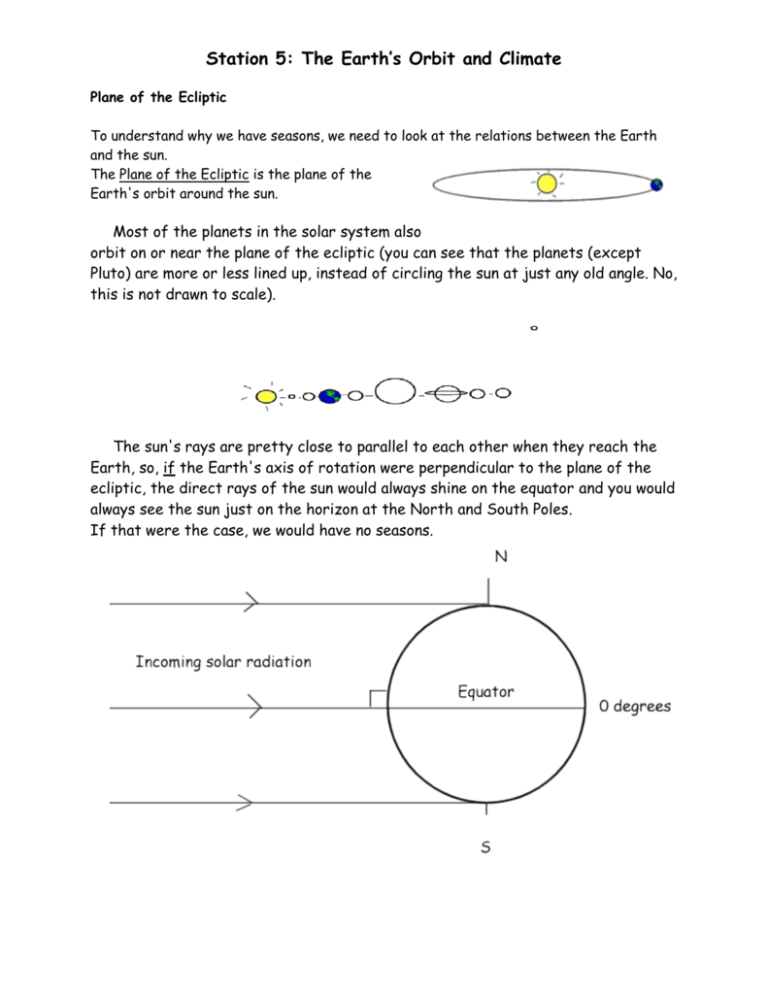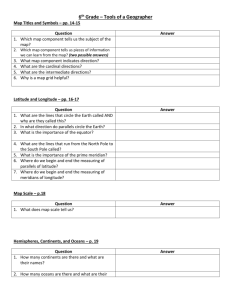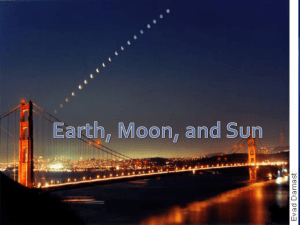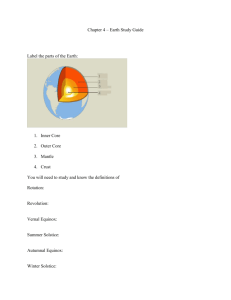Orbit and seasons
advertisement

Station 5: The Earth’s Orbit and Climate Plane of the Ecliptic To understand why we have seasons, we need to look at the relations between the Earth and the sun. The Plane of the Ecliptic is the plane of the Earth's orbit around the sun. Most of the planets in the solar system also orbit on or near the plane of the ecliptic (you can see that the planets (except Pluto) are more or less lined up, instead of circling the sun at just any old angle. No, this is not drawn to scale). The sun's rays are pretty close to parallel to each other when they reach the Earth, so, if the Earth's axis of rotation were perpendicular to the plane of the ecliptic, the direct rays of the sun would always shine on the equator and you would always see the sun just on the horizon at the North and South Poles. If that were the case, we would have no seasons. Earth’s Tilt However, the Earth's axis is not perpendicular to the plane of the ecliptic. If you drew a line perpendicular to the plane of the ecliptic, the Earth's axis of rotation would be tilted, or inclined, at an angle of about 23 1/2 degrees with respect to the perpendicular line. It is this inclination of the Earth's axis of rotation that is the reason for the seasons. The earth maintains the same angle of inclination throughout its orbit. Another way of saying this is that the earth’s axis is parallel to itself at all points in its orbit. The inclination of the Earth's axis means that at different locations on its orbit around the sun, different parts of the earth are tilted toward the sun, and the part that is tilted toward the sun is the part that is having summer. If the northern hemisphere is tilted toward the sun, the northern hemisphere receives the most direct rays of the sun and it is summer in the northern hemisphere. If the southern hemisphere is tilted toward the sun, the southern hemisphere receives the most direct rays of the sun, and it is summer in the southern hemisphere. In the intermediate situations, halfway between the two extremes, the Earth's axis is still tilted, but not tilted with respect to the sun's rays, and the sun's rays strike directly on the Equator. June Solstice Let's look at this more closely. At one point in its orbit, the northern part of the earth has its maximum inclination toward the sun. Since the earth's axis is tilted 23 ½ degrees, then on this particular day, the sun's rays are striking the earth directly at a latitude approximately 23 ½ degrees north of the equator This occurs on about June 21 or 22 each year, and the day is known as the Summer Solstice (summer for those who live in the Northern Hemisphere, that is. It might be safer and more generally applicable to call it the June Solstice). If you were at 23 1/2 degrees north latitude on that day, and you looked up at noon, the sun would be directly overhead. This latitude is the farthest north on the Earth that the sun's rays will be directly overhead. Farther north, at noon, the sun will never be directly overhead, but always at least a little bit to the south. The latitude of 23 ½ degrees north is known as the Tropic of Cancer, and it is the northern boundary of the tropics. What else is happening at this time? Look at the circle of illumination, and see where it is. Half of the earth is illuminated, but the circle of illumination does not pass through the north and south poles, as would be the case if the earth's axis were not tilted. Instead, the sun's rays pass over the North Pole and in fact go "over the top" to a latitude 23 ½ degrees south of the NP. Since the NP is 90 degrees north, the C of I goes to 66 ½ degrees north (90-23.5=66.5). This is the Arctic Circle, and on this day, June 21 or 22, every location north of the Arctic Circle is illuminated for the entire 24 hours (this is the Land of the Midnight sun; the sun does not rise or set here on the solstice, but just circles around above the horizon). On the other end of the globe, the circle of illumination never reaches the south pole, and in fact it doesn't get to within 23 ½ degrees of the south pole. So every place more than 66 ½ degrees south of the equator misses out on the sun's rays entirely that day-they get 24 hours of darkness (twilight, really, since the sun is not that far below the horizon). The latitude 66 ½ degrees south is known as the Antarctic Circle. December Solstice Let's take a look at the opposite end of the year, six months later, on December 21 or 22. On this day, the earth has gone halfway around its orbit, and is opposite the point where it was on the summer solstice. The situation is exactly reversed. The southern hemisphere of the earth is tilted toward the sun, and the sun's rays are perpendicular to the earth's surface at 23 ½ degrees south. This is the subsolar point: the sun is directly overhead at noon at this latitude. The farthest south that the sun's rays shine directly is latitude 23 ½ degrees south, the Tropic of Capricorn. This is the southern boundary of the tropics. On this day, the area north of the Arctic Circle gets no sunlight, and the area south of the Antarctic Circle gets 24 hours of light. This is called the Winter Solstice (or the December Solstice). It is summer for the Southern Hemisphere (and the longest day of the year for the Southern Hemisphere), and winter for the Northern Hemisphere (and the shortest day of the year for the Northern Hemisphere). Equinoxes Now for the intermediate situation. The subsolar point is at the Tropic of Cancer in June, and at the Tropic of Capricorn in December. Midway between the solstices are two dates when the sun shines directly on the equator, and we have a situation like our hypothetical one, where the earth's axis is perpendicular to the ecliptic. (The axis is still tilted, still pointing at the North Star, but it is tilted sideways with respect to the sun, rather than towards or away from the sun). The circle of illumination passes through the poles, the sun's rays strike the equator at an angle of 90 degrees, and every part of the earth has 12 hours of daylight and twelve hours of night. This happens twice in the year. These two days are called the equinoxes. (equinox means equal night, since days and night are equal at twelve hours). March 20 or 21 is the vernal equinox or spring equinox (for the Northern Hemisphere), and September 22 or 23 is the autumnal equinox, or fall equinox (for the Northern Hemisphere). Throughout the year, daylength is 12 hours at equator. At the Poles, daylength varies from none (at the winter solstice for that hemisphere) to 24 hours (at the summer solstice for that hemisphere). At points in between, daylength will be somewhere in between. The closer a location is to the Equator, the more even the daylength is, not varying much from twelve hours all year. At high latitudes, the daylength is very long in the summer, and very short in the winter. Earth’s Orbit One more point about the Earth's orbit: By now you know that the reason we have seasons is the tilt of the Earth's axis. But sometimes people wonder if seasons have anything to do with the distance of the Earth from the sun. We know that can't be the case, because the seasons are opposite in the Northern and Southern Hemispheres. However, if we look at the Earth's orbit closely, we find that it is not exactly circular. Rather, it is an ellipse, which is an oval shape, or a very slightly flattened circle. The sun is at one focus of the ellipse. This means that the Earth's distance from the sun does vary. The point where the Earth is closest to the sun is called perihelion (from the Greek peri, close or near, and helios, meaning sun). Perihelion takes place on January 3, which, of course, is during winter for the Northern Hemisphere, and summer for the Southern Hemisphere. The point where the Earth is farthest away from the sun is called aphelion (Greek ap, away from, and helios, sun). So, actually the Earth and sun are closest during the Southern Hemisphere summer. Does this mean that the summers are hotter in the Southern Hemisphere? Well, the Southern Hemisphere does get a little more insolation during summer, but the effects of this are moderated, because the Southern Hemisphere is a water hemisphere (lots of ocean; take a look at a globe), and the water absorbs the extra heat. So the differences in summer heating between the two hemispheres are not really very noticeable.









